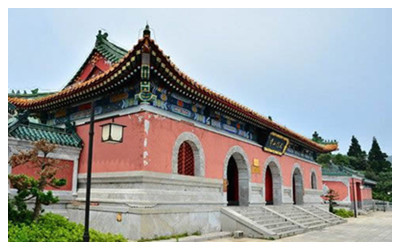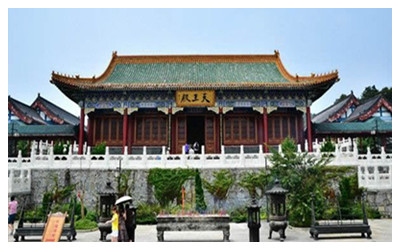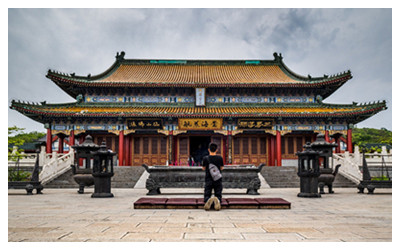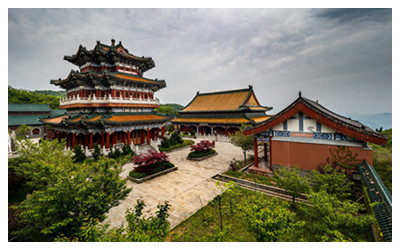Skype: neodalle-travel
Tel: +86 135 7447 2266
E-mail: sales@visitaroundchina.com

Buddhism was introduced into China mainly during Eastern Han Dynasty (25-220) . The Buddhist temple adapted to Chinese tastes when it arrived in China. Chinese Buddhist temple bears very little resemblance to the temples in India or other Buddhist countries. Taking the layout of traditional Chinese imperial palace architecture, Chinese Buddhist temple usually has a group of courtyards and halls set on the north-south axis with side rooms flanked symmetrically on each side.

Let's visit Tianmen Mountain Temple, and you can know more information about Chinese Buddhist Temple
Mountain Gate (Shan Men)
The Mountain Gate is the entrance or introductory part of the temple, usually followed by a solemn screen wall to prevent a direct peering from outside the temple. This principle can be found in most Chinese courtyard structure as well.
Forecourt ( Heavenly Kings Hall)
 After entering the gate there is the first courtyard, also called forecourt. Bell Tower and Drum Towers are two-storied structures, set symmetrically on each side of the yard. In the past times, bells and drums were used as a time alert. Nowadays they no longer have any function like that. In small temples, they were replaced by pavilions. There is a leading way in the middle to the Heavenly Kings Hall (variably spelt as Tian Wang Dian or Devaraja Hall), the first main hall on the axis. In this hall, a smiling Maitreya (known to the west as Laughing Buddha) is set on the middle altar. Four fierce-looking Heavenly Kings (warrior guardians) stand into two groups on each side.
After entering the gate there is the first courtyard, also called forecourt. Bell Tower and Drum Towers are two-storied structures, set symmetrically on each side of the yard. In the past times, bells and drums were used as a time alert. Nowadays they no longer have any function like that. In small temples, they were replaced by pavilions. There is a leading way in the middle to the Heavenly Kings Hall (variably spelt as Tian Wang Dian or Devaraja Hall), the first main hall on the axis. In this hall, a smiling Maitreya (known to the west as Laughing Buddha) is set on the middle altar. Four fierce-looking Heavenly Kings (warrior guardians) stand into two groups on each side.
 The second courtyard (Main Buddha Hall)
The second courtyard (Main Buddha Hall)
Leaving the Heavenly Kings Hall, you enter the second courtyard, the principle part of the temple which include the Main Buddha Hall and several flanking rooms. The Main Buddha Hall stands on a high terrace or foundation with marble balustrades. The height of the terrace or foundation depends on the importance of the temple. The hall is variably named Daxiongbaodian Hall or Hall of XX Buddha according to who are set in it. A common case is the Buddha trinity (the trinity of the three ages) including the Buddha of the Present, Sakyamuni, the Buddha of the Past, Kasyapa (Jiayefo in Chinese Pinyin) and the Buddha of the Future, Maitreya or another trinity often found in Chan temples of Sakyamuni, Amitabha (Emitofo) and Bhaisajyaguru (Yaoshifo, the God of Medicine). The case varies with different Buddhist schools and periods in which the temples were built. One thing for sure is that Buddhas or Bodhisattvas in the Main Buddha Hall are supposed to be superior to those in other halls.
Ding (huge bronze)
A huge bronze incense burner or Ding - a kind of bronze cooking vessel is used for religious or ritual ceremonies and is found in front of the Main Buddha Hall for people to burn incense for prayer. Side rooms in this courtyard house other Buddhas or reputed dignitary.
 Sutra Keeping Tower(Cang Jing Ge)
Sutra Keeping Tower(Cang Jing Ge)
Behind the Mail Buddha Hall is another courtyard with more halls serving as other purposes. A library hall, often a two-storied tower in which Buddhist sutras, scriptures, and books are kept is called Cang Jing Ge (Sutra Keeping Tower or Sutra Hall). It is usually found at the rear part of the courtyard. Living residences or quarters are set at the corner of the rear part for monks and pupils.
Most Buddhist temples follow the layout mentioned above and numbers of gates, halls and courtyards varies according to the size and scale of the temple.
 Ask Questions ?
Ask Questions ?